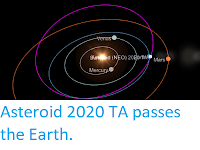Asteroid 2020 SX3 passed by the Earth at a distance of about 1 699 00 km (4.42 times the average distance between the Earth and the Moon, or 1.14% of the distance between the Earth and the Sun), at about 11.15 am GMT on Thurday 8 October 2020. There was no danger of the asteroid hitting us, though were it to do so it would not have presented a significant threat. 2020 SX3 has an estimated equivalent diameter of 28-88 m (i.e. it is estimated that a spherical object with the same volume would be 28-88 m in diameter), and an object of this size would be expected to explode in an airburst (an explosion caused by superheating from friction with the Earth's atmosphere, which is greater than that caused by simply falling, due to the orbital momentum of the asteroid) in the atmosphere between 17 and 0.5 km above the ground, although an object at the upper end of this range would be expected to produce an explosion 1800 times as large as the one generated by the Hiroshima bomb, being directly underneath it might be fairly unpleasant.
2020 SX3 was discovered on 22 September 2020 (fifteen days before its closest approach to the Earth) by the University of Arizona's Mt. Lemmon Survey at the Steward Observatory on Mount Lemmon in the Catalina Mountains north of Tucson. The designation 2020 SX3 implies that the asteroid was the 95th object (asteroid X3 - in numbering asteroids the letters A-Y, excluding I, are assigned numbers from 1 to 24, with a number added to the end each time the alphabet is ended, so that A = 1, A1 = 25, A2 = 49, etc., which means that X3 = (24 x 3) + 23 = 110) discovered in the second half of September 2020 (period 2020 S - the year being split into 24 half-months represented by the letters A-Y, with I being excluded).
2020 SX3 has a 1581 day (4.33 year) orbital period, with an elliptical orbit tilted at an angle of 2.45° to the plain of the Solar System which takes in to 0.93 AU from the Sun (93% of the distance at which the Earth orbits the Sun) and out to 4.38 AU (4.38% of the distance at which the Earth orbits the Sun, and almost three times the distance at which the planet Mars orbits the Sun). This means that close encounters between the asteroid and Earth are fairly common, with the last thought to have happened in January 2008 and the next predicted in September 2033. It is therefore classed as an Apollo Group Asteroid (an asteroid that is on average further from the Sun than the Earth, but which does get closer). 2020 SX3 also has occasional close encounters with the planet Jupiter, which is last came close to in July 2018 and is expected to come close to again in September 2051.
See also...



Follow Sciency Thoughts on Facebook.
Follow Sciency Thoughts on Twitter.






